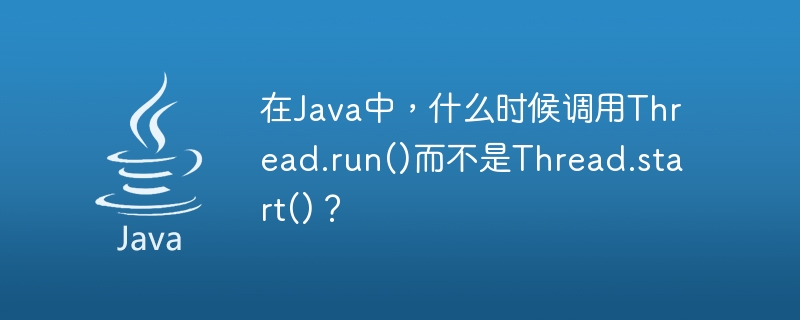Java에서 Thread.start() 대신 Thread.run()을 언제 호출해야 합니까?
- WBOYWBOYWBOYWBOYWBOYWBOYWBOYWBOYWBOYWBOYWBOYWBOYWB앞으로
- 2023-09-15 12:13:021278검색

스레드에서 start() 메서드를 호출하면 스레드가 실행을 시작하고 스레드의 run() 메서드가 Java Virtual Machine (JVM)에 의해 호출됩니다. run() 메소드를 직접 호출하면 스레드 클래스(또는 실행 가능 인터페이스)의 일반적인 재정의된 메소드로 처리되며 스레드가 아닌 현재 스레드의 컨텍스트에서 실행됩니다. 실행 중인 새 스레드.
Example
public class CallRunMethodTest extends Thread {
@Override
public void run() {
System.out.println("In the run() method: " + Thread.currentThread().getName());
for(int i = 0; i < 5 ; i++) {
System.out.println("i: " + i);
try {
Thread.sleep(300);
} catch (InterruptedException ie) {
ie.printStackTrace();
}
}
}
public static void main(String[] args) {
CallRunMethodTest t1 = new CallRunMethodTest();
CallRunMethodTest t2 = new CallRunMethodTest();
t1.run(); <strong>// calling run() method directly instead of start() method</strong>
t2.run(); <strong>// calling run() method directly instead of start() method</strong>
}
}위의 예에서는 두 개의 스레드가 생성되고 start() 메서드를 호출하는 대신 스레드에서 run() 메서드가 직접 호출됩니다.
출력
In the run() method: main i: 0 i: 1 i: 2 i: 3 i: 4 In the run() method: main i: 0 i: 1 i: 2 i: 3 i: 4
위 내용은 Java에서 Thread.start() 대신 Thread.run()을 언제 호출해야 합니까?의 상세 내용입니다. 자세한 내용은 PHP 중국어 웹사이트의 기타 관련 기사를 참조하세요!
성명:
이 기사는 tutorialspoint.com에서 복제됩니다. 침해가 있는 경우 admin@php.cn으로 문의하시기 바랍니다. 삭제
이전 기사:Java 9 모듈의 이점은 무엇입니까?다음 기사:Java 9 모듈의 이점은 무엇입니까?

